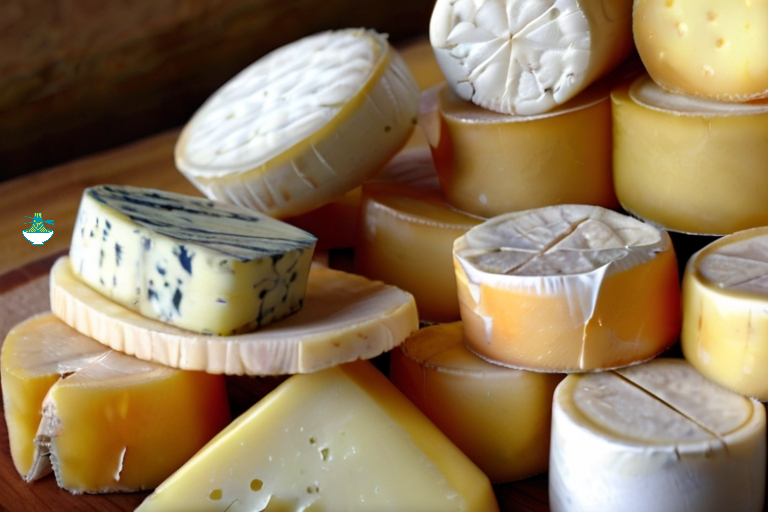Indulge your senses in a gastronomic journey through the fascinating world of cheese with "Fromage Finery." This delectable exploration takes you on a tour of diverse flavors, textures, and aromas that cheese has to offer. Delve into the rich history and cultural significance of this beloved dairy product, from its ancient origins to modern artisanal craftsmanship.

Discover the artistry behind the production of renowned cheeses from various regions around the globe. From creamy Bries of France to tangy Goudas of the Netherlands, each cheese tells a unique story steeped in tradition and craftsmanship.
Uncover the secrets of cheese pairing, as you learn to complement different varieties with an array of accompaniments, from fruits and nuts to wines and crackers. Whether you're a cheese connoisseur or a novice enthusiast, "Fromage Finery" promises to elevate your appreciation and understanding of this timeless culinary delight. Embark on a flavorful voyage that celebrates the diversity and complexity of cheese, and let your taste buds savor the sublime pleasure of each exquisite bite.
Ingredients:
- 1 gallon (3.8 liters) of whole milk
- 1/4 cup of white vinegar or lemon juice
- Salt to taste
- Fresh herbs (optional, for flavor)

Instructions:
1- Pour the milk into a large, heavy-bottomed pot and heat it over medium heat. Stir frequently to prevent scorching.
2- Heat the milk until it reaches a temperature of around 185°F (85°C). Use a thermometer to monitor the temperature accurately.
3- Once the milk reaches the desired temperature, remove it from the heat and stir in the white vinegar or lemon juice. Stir gently for about 1-2 minutes to ensure the acid is evenly distributed.
4- Let the milk sit undisturbed for about 10-15 minutes to allow the curds to form. You'll notice the milk starting to separate into curds (solid) and whey (liquid).
5- Line a colander with cheesecloth and place it over a large bowl or in the sink. Carefully pour the curdled milk into the colander to strain out the whey. The curds will remain in the cheesecloth.
6- Once most of the whey has drained off, gather the corners of the cheesecloth and tie them together to form a bundle. Hang the bundle over the sink or a large bowl to allow the remaining whey to drip off. Let it hang for about 1-2 hours, or until the cheese reaches your desired consistency.
7- After draining, transfer the cheese to a mixing bowl and season with salt to taste. You can also mix in fresh herbs like thyme, oregano, or basil for added flavor, if desired.
8- Once seasoned, pack the cheese into a mold or container and refrigerate it for at least 2-3 hours to firm up.
9- Serve your homemade Djiboutian cheese as part of a breakfast spread or snack, accompanied by bread, crackers, or fresh fruit. Enjoy the creamy texture and delicate flavor of this delightful cheese!
Note: Djiboutian cheese is traditionally mild and creamy, so adjust the salt and seasoning according to your preference. This recipe yields a fresh, soft cheese similar to cottage cheese or queso blanco, perfect for spreading or dipping.
Nutritional Values:
Here are approximate nutritional values for the main ingredients used in the Djiboutian Cheese recipe:
Whole Milk (per 1 cup serving):
- Calories: 149
- Protein: 7.7g
- Fat: 7.9g
- Carbohydrates: 11.7g
- Calcium: 276mg
- Vitamin D: 120 IU
benefits:
- Provides essential nutrients like protein, calcium, and vitamin D, which are important for bone health.
- Contains fats that contribute to energy production and aid in the absorption of fat-soluble vitamins.
- Offers carbohydrates for energy and sustenance.
White Vinegar (per 1 tablespoon):
- Calories: 3
- Total Fat: 0g
- Sodium: 0.7mg
- Total Carbohydrates: 0.1g
- Sugars: 0g
benefits:
- Acts as an acidifying agent, helping to curdle the milk and separate it into curds and whey during the cheese-making process.
- Adds a tangy flavor to the cheese.
Lemon Juice (per 1 tablespoon):
- Calories: 4
- Total Fat: 0g
- Sodium: 0.2mg
- Total Carbohydrates: 1.3g
- Sugars: 0.4g
benefits:
- Serves as an acidic component similar to vinegar, aiding in the coagulation of the milk proteins and the formation of curds.
- Imparts a subtle citrus flavor to the cheese.
Salt (per 1 teaspoon):
- Calories: 0
- Sodium: 2,325mg
benefits:
- Enhances the flavor of the cheese by providing a balanced taste.
- Helps to preserve the cheese by inhibiting the growth of harmful bacteria.
- Plays a role in regulating fluid balance and nerve function in the body when consumed in moderation.
Please note that these values are approximate and can vary based on factors such as brand, processing methods, and specific product variations. Additionally, the nutritional values for the final cheese product will depend on how much salt is added and any additional ingredients used for seasoning.


Comments